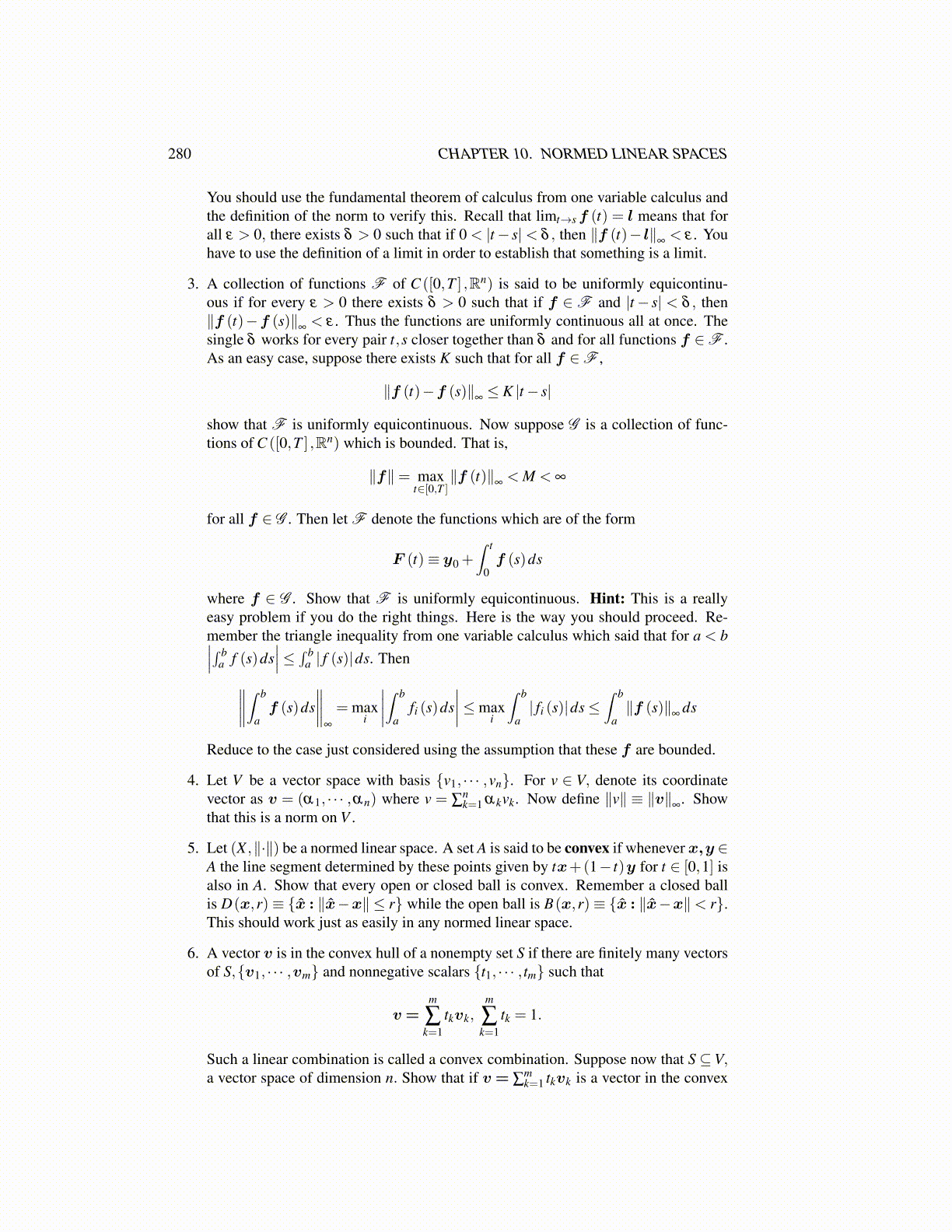
280 CHAPTER 10. NORMED LINEAR SPACES
You should use the fundamental theorem of calculus from one variable calculus andthe definition of the norm to verify this. Recall that limt→sf (t) = l means that forall ε > 0, there exists δ > 0 such that if 0 < |t− s| < δ , then ∥f (t)− l∥
∞< ε . You
have to use the definition of a limit in order to establish that something is a limit.
3. A collection of functions F of C ([0,T ] ,Rn) is said to be uniformly equicontinu-ous if for every ε > 0 there exists δ > 0 such that if f ∈ F and |t− s| < δ , then∥f (t)−f (s)∥
∞< ε . Thus the functions are uniformly continuous all at once. The
single δ works for every pair t,s closer together than δ and for all functions f ∈F .As an easy case, suppose there exists K such that for all f ∈F ,
∥f (t)−f (s)∥∞≤ K |t− s|
show that F is uniformly equicontinuous. Now suppose G is a collection of func-tions of C ([0,T ] ,Rn) which is bounded. That is,
∥f∥= maxt∈[0,T ]
∥f (t)∥∞< M < ∞
for all f ∈ G . Then let F denote the functions which are of the form
F (t)≡ y0 +∫ t
0f (s)ds
where f ∈ G . Show that F is uniformly equicontinuous. Hint: This is a reallyeasy problem if you do the right things. Here is the way you should proceed. Re-member the triangle inequality from one variable calculus which said that for a < b∣∣∣∫ b
a f (s)ds∣∣∣≤ ∫ b
a | f (s)|ds. Then∥∥∥∥∫ b
af (s)ds
∥∥∥∥∞
= maxi
∣∣∣∣∫ b
afi (s)ds
∣∣∣∣≤maxi
∫ b
a| fi (s)|ds≤
∫ b
a∥f (s)∥
∞ds
Reduce to the case just considered using the assumption that these f are bounded.
4. Let V be a vector space with basis {v1, · · · ,vn}. For v ∈ V, denote its coordinatevector as v = (α1, · · · ,αn) where v = ∑
nk=1 αkvk. Now define ∥v∥ ≡ ∥v∥
∞. Show
that this is a norm on V .
5. Let (X ,∥·∥) be a normed linear space. A set A is said to be convex if whenever x,y ∈A the line segment determined by these points given by tx+(1− t)y for t ∈ [0,1] isalso in A. Show that every open or closed ball is convex. Remember a closed ballis D(x,r)≡ {x̂ : ∥x̂−x∥ ≤ r} while the open ball is B(x,r)≡ {x̂ : ∥x̂−x∥< r}.This should work just as easily in any normed linear space.
6. A vector v is in the convex hull of a nonempty set S if there are finitely many vectorsof S,{v1, · · · ,vm} and nonnegative scalars {t1, · · · , tm} such that
v =m
∑k=1
tkvk,m
∑k=1
tk = 1.
Such a linear combination is called a convex combination. Suppose now that S ⊆V,a vector space of dimension n. Show that if v = ∑
mk=1 tkvk is a vector in the convex